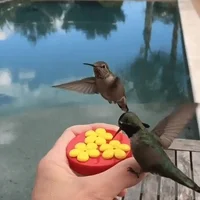Understanding
Hummingbird Behaviour and Evolution
By Joseph Mathieu
But observed in controlled
environments, the birds that can weigh less than a nickel and turn on a dime
have a lot to show.
Especially to Carleton
University’s Roslyn Dakin, who wants to understand how hummingbirds evolved to solve
their problems.
“I was always fascinated by
evolution,” says Dakin.
“It just seemed like this
mind-blowing thing that species could change and that we could understand that
process.”
Dakin specializes in behavioural
data and analyzing the movements of birds to understand how they control their
movement. As she sets up her lab in Carleton’s Department of Biology, she will begin teaching the first-year course Biological
Methods, Analysis and Interpretation this fall.
“I’m really excited to teach that to the next generation of biologists,” she says. “If it wasn’t for that foundation of quantitative skills, I wouldn’t be able to address the biological questions that I’m interested in.”
Due to their high metabolism—and the
fact they can beat their wings as much as 50 times a second—hummingbirds need
to eat often.
“They have to eat every 10 to 20
minutes. That ends up being a huge advantage for us when we’re studying
behaviour,” she says.
“We can set up an environment in the
lab that will have them perform a particular behaviour in order for them to
feed.”
They are also unique subjects to
observe. Hummingbirds are incredibly agile and versatile flyers, the only group
of birds that can also fly backwards and hover for extended periods of time.
And for a bird that might weigh as much as four raisins, they can be mighty
competitors.
“The males also do weird displays
for females, either shuttling side to side or flying way up in the air and then
diving, swooping over a female’s head.”
Applying the Mechanics of Animal
Behaviour to Industry
The mechanics of animal behaviour
can apply to many different industries.
New knowledge could potentially
improve the performance of flying drones and autonomous vehicles that need to
maneuver in cluttered spaces, and it could change the way large windows and
other man-made structures are designed to prevent many, if not all, of hundreds
of millions of bird deaths each year.
Dakin began observing pigeon flocks
on downtown Kingston rooftops as an undergraduate student at Queen’s University
and, for her PhD thesis, she studied how peacocks use rapid movements of their
colourful feathers to impress their mates.
The opportunity to study
hummingbirds arose as a postdoctorate study with Doug Altshuler at the
University of British Columbia. Dakin created experiments in a flight tunnel
designed by UBC grad student Tyee Fellows and used software developed by Andrew
Straw of the University of Freiburg in Germany.
“I remember the first time I ran a
pilot study that successfully altered the way the hummingbirds navigated their
environment — I was hooked!”
New Research Only the Beginning
Last February, their study was
published in Science.
Through sophisticated software, Dakin and her colleagues filmed the flight of
more than 200 wild-caught hummingbirds in Costa Rica from 25 different species.
Using 200-frames-per-second footage, they recorded more than 330,000
manoeuvers.
They determined that larger
hummingbird species are more effective at accelerating and making tight turns,
contrary to other types of birds and animals.
The next step is to comb through the
data for more revelations about how hummingbird behaviour evolved within and
among the different species.
“We do still have questions about
that. We’ve published one study on the comparison on these different
hummingbird species. But that’s really only the beginning.”
